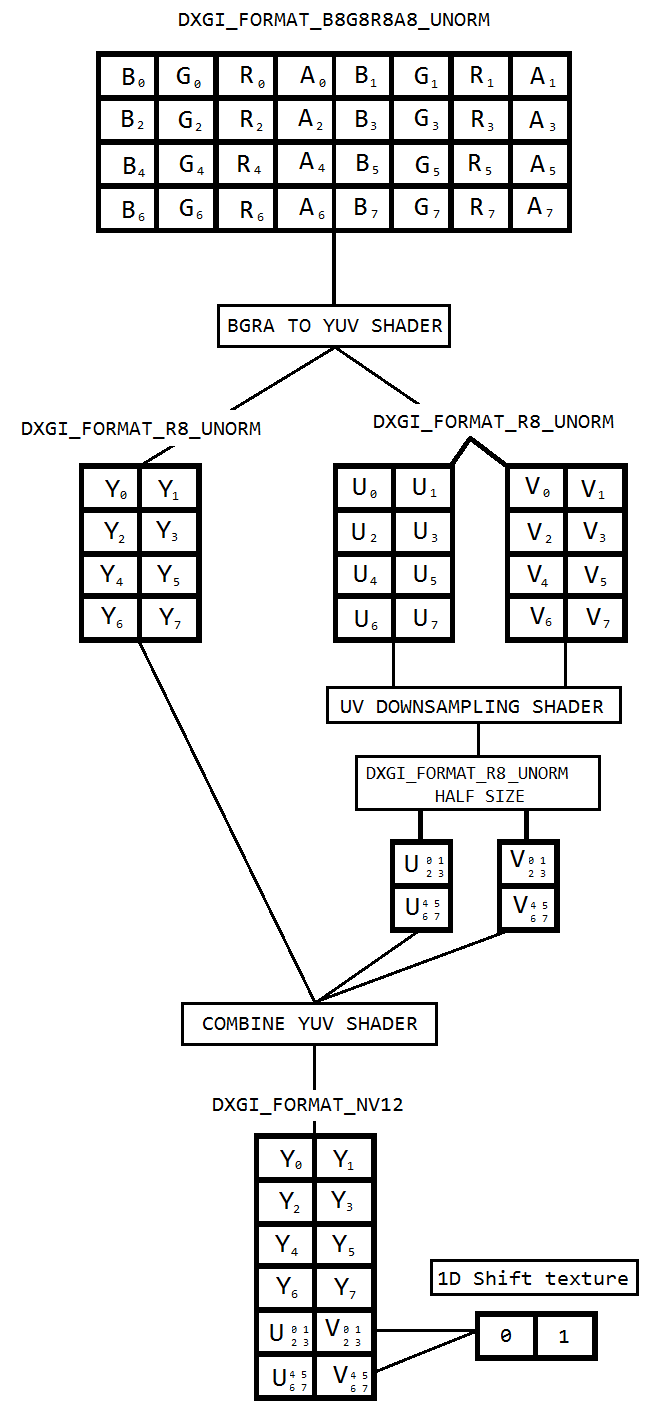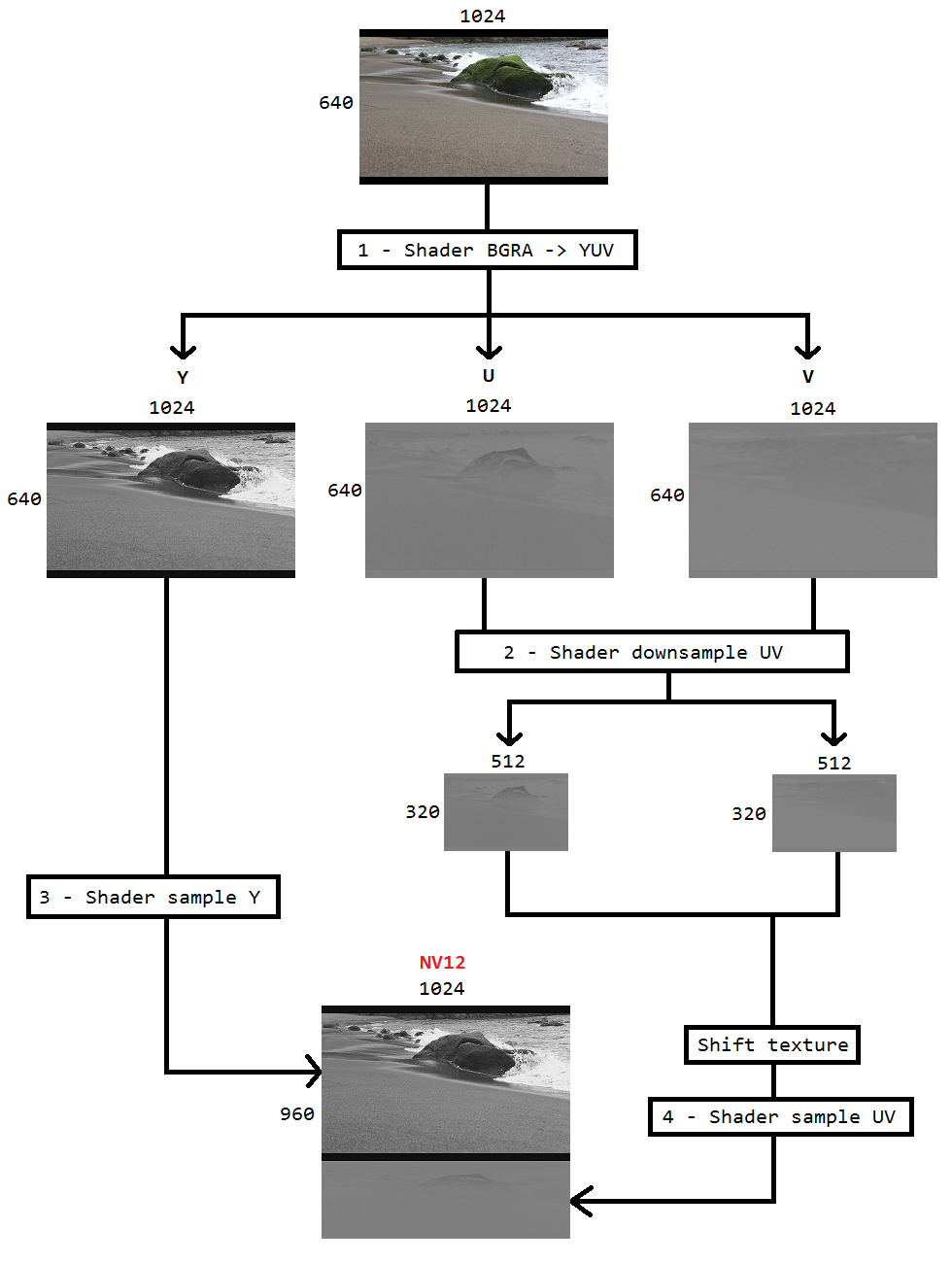I'm working on a code to capture the desktop using Desktop duplication and encode the same to h264 using Intel hardwareMFT. The encoder only accepts NV12 format as input. I have got a DXGI_FORMAT_B8G8R8A8_UNORM to NV12 converter(https://github.com/NVIDIA/video-sdk-samples/blob/master/nvEncDXGIOutputDuplicationSample/Preproc.cpp) that works fine, and is based on DirectX VideoProcessor.
The problem is that the VideoProcessor on certain intel graphics hardware supports conversions only from DXGI_FORMAT_B8G8R8A8_UNORM to YUY2 but not NV12, I have confirmed the same by enumerating the supported formats through GetVideoProcessorOutputFormats. Though the VideoProcessor Blt succeeded without any errors, and I could see that the frames in the output video are pixelated a bit, I could notice it if I look at it closely.
I guess, the VideoProcessor has simply failed over to the next supported output format (YUY2) and I'm unknowingly feeding it to the encoder that thinks that the input is in NV12 as configured. There is no failure or major corruption of frames due to the fact that there is little difference like byte order and subsampling between NV12 and YUY2. Also, I don't have pixelating problems on hardware that supports NV12 conversion.
So I decided to do the color conversion using pixel shaders which is based on this code(https://github.com/bavulapati/DXGICaptureDXColorSpaceConversionIntelEncode/blob/master/DXGICaptureDXColorSpaceConversionIntelEncode/DuplicationManager.cpp). I'm able make the pixel shaders work, I have also uploaded my code here(https://codeshare.io/5PJjxP) for reference (simplified it as much as possible).
Now, I'm left with two channels, chroma, and luma respectively (ID3D11Texture2D textures). And I'm really confused about efficiently packing the two separate channels into one ID3D11Texture2D texture so that I may feed the same to the encoder. Is there a way to efficiently pack the Y and UV channels into a single ID3D11Texture2D in GPU? I'm really tired of CPU based approaches due to the fact that it's costly, and doesn't offer the best possible frame rates. In fact, I'm reluctant to even copy the textures to CPU. I'm thinking of a way to do it in GPU without any back and forth copies between CPU and GPU.
I have been researching this for quite some time without any progress, any help would be appreciated.
/**
* This method is incomplete. It's just a template of what I want to achieve.
*/
HRESULT CreateNV12TextureFromLumaAndChromaSurface(ID3D11Texture2D** pOutputTexture)
{
HRESULT hr = S_OK;
try
{
//Copying from GPU to CPU. Bad :(
m_pD3D11DeviceContext->CopyResource(m_CPUAccessibleLuminanceSurf, m_LuminanceSurf);
D3D11_MAPPED_SUBRESOURCE resource;
UINT subresource = D3D11CalcSubresource(0, 0, 0);
HRESULT hr = m_pD3D11DeviceContext->Map(m_CPUAccessibleLuminanceSurf, subresource, D3D11_MAP_READ, 0, &resource);
BYTE* sptr = reinterpret_cast<BYTE*>(resource.pData);
BYTE* dptrY = nullptr; // point to the address of Y channel in output surface
//Store Image Pitch
int m_ImagePitch = resource.RowPitch;
int height = GetImageHeight();
int width = GetImageWidth();
for (int i = 0; i < height; i++)
{
memcpy_s(dptrY, m_ImagePitch, sptr, m_ImagePitch);
sptr += m_ImagePitch;
dptrY += m_ImagePitch;
}
m_pD3D11DeviceContext->Unmap(m_CPUAccessibleLuminanceSurf, subresource);
//Copying from GPU to CPU. Bad :(
m_pD3D11DeviceContext->CopyResource(m_CPUAccessibleChrominanceSurf, m_ChrominanceSurf);
hr = m_pD3D11DeviceContext->Map(m_CPUAccessibleChrominanceSurf, subresource, D3D11_MAP_READ, 0, &resource);
sptr = reinterpret_cast<BYTE*>(resource.pData);
BYTE* dptrUV = nullptr; // point to the address of UV channel in output surface
m_ImagePitch = resource.RowPitch;
height /= 2;
width /= 2;
for (int i = 0; i < height; i++)
{
memcpy_s(dptrUV, m_ImagePitch, sptr, m_ImagePitch);
sptr += m_ImagePitch;
dptrUV += m_ImagePitch;
}
m_pD3D11DeviceContext->Unmap(m_CPUAccessibleChrominanceSurf, subresource);
}
catch(HRESULT){}
return hr;
}
Draw NV12:
//
// Draw frame for NV12 texture
//
HRESULT DrawNV12Frame(ID3D11Texture2D* inputTexture)
{
HRESULT hr;
// If window was resized, resize swapchain
if (!m_bIntialized)
{
HRESULT Ret = InitializeNV12Surfaces(inputTexture);
if (!SUCCEEDED(Ret))
{
return Ret;
}
m_bIntialized = true;
}
m_pD3D11DeviceContext->CopyResource(m_ShaderResourceSurf, inputTexture);
D3D11_TEXTURE2D_DESC FrameDesc;
m_ShaderResourceSurf->GetDesc(&FrameDesc);
D3D11_SHADER_RESOURCE_VIEW_DESC ShaderDesc;
ShaderDesc.Format = FrameDesc.Format;
ShaderDesc.ViewDimension = D3D11_SRV_DIMENSION_TEXTURE2D;
ShaderDesc.Texture2D.MostDetailedMip = FrameDesc.MipLevels - 1;
ShaderDesc.Texture2D.MipLevels = FrameDesc.MipLevels;
// Create new shader resource view
ID3D11ShaderResourceView* ShaderResource = nullptr;
hr = m_pD3D11Device->CreateShaderResourceView(m_ShaderResourceSurf, &ShaderDesc, &ShaderResource);
IF_FAILED_THROW(hr);
m_pD3D11DeviceContext->PSSetShaderResources(0, 1, &ShaderResource);
// Set resources
m_pD3D11DeviceContext->OMSetRenderTargets(1, &m_pLumaRT, nullptr);
m_pD3D11DeviceContext->PSSetShader(m_pPixelShaderLuma, nullptr, 0);
m_pD3D11DeviceContext->RSSetViewports(1, &m_VPLuminance);
// Draw textured quad onto render target
m_pD3D11DeviceContext->Draw(NUMVERTICES, 0);
m_pD3D11DeviceContext->OMSetRenderTargets(1, &m_pChromaRT, nullptr);
m_pD3D11DeviceContext->PSSetShader(m_pPixelShaderChroma, nullptr, 0);
m_pD3D11DeviceContext->RSSetViewports(1, &m_VPChrominance);
// Draw textured quad onto render target
m_pD3D11DeviceContext->Draw(NUMVERTICES, 0);
// Release shader resource
ShaderResource->Release();
ShaderResource = nullptr;
return S_OK;
}
Init shaders:
void SetViewPort(D3D11_VIEWPORT* VP, UINT Width, UINT Height)
{
VP->Width = static_cast<FLOAT>(Width);
VP->Height = static_cast<FLOAT>(Height);
VP->MinDepth = 0.0f;
VP->MaxDepth = 1.0f;
VP->TopLeftX = 0;
VP->TopLeftY = 0;
}
HRESULT MakeRTV(ID3D11RenderTargetView** pRTV, ID3D11Texture2D* pSurf)
{
if (*pRTV)
{
(*pRTV)->Release();
*pRTV = nullptr;
}
// Create a render target view
HRESULT hr = m_pD3D11Device->CreateRenderTargetView(pSurf, nullptr, pRTV);
IF_FAILED_THROW(hr);
return S_OK;
}
HRESULT InitializeNV12Surfaces(ID3D11Texture2D* inputTexture)
{
ReleaseSurfaces();
D3D11_TEXTURE2D_DESC lOutputDuplDesc;
inputTexture->GetDesc(&lOutputDuplDesc);
// Create shared texture for all duplication threads to draw into
D3D11_TEXTURE2D_DESC DeskTexD;
RtlZeroMemory(&DeskTexD, sizeof(D3D11_TEXTURE2D_DESC));
DeskTexD.Width = lOutputDuplDesc.Width;
DeskTexD.Height = lOutputDuplDesc.Height;
DeskTexD.MipLevels = 1;
DeskTexD.ArraySize = 1;
DeskTexD.Format = lOutputDuplDesc.Format;
DeskTexD.SampleDesc.Count = 1;
DeskTexD.Usage = D3D11_USAGE_DEFAULT;
DeskTexD.BindFlags = D3D11_BIND_SHADER_RESOURCE;
HRESULT hr = m_pD3D11Device->CreateTexture2D(&DeskTexD, nullptr, &m_ShaderResourceSurf);
IF_FAILED_THROW(hr);
DeskTexD.Format = DXGI_FORMAT_R8_UNORM;
DeskTexD.BindFlags = D3D11_BIND_RENDER_TARGET;
hr = m_pD3D11Device->CreateTexture2D(&DeskTexD, nullptr, &m_LuminanceSurf);
IF_FAILED_THROW(hr);
DeskTexD.CPUAccessFlags = D3D11_CPU_ACCESS_READ;
DeskTexD.Usage = D3D11_USAGE_STAGING;
DeskTexD.BindFlags = 0;
hr = m_pD3D11Device->CreateTexture2D(&DeskTexD, NULL, &m_CPUAccessibleLuminanceSurf);
IF_FAILED_THROW(hr);
SetViewPort(&m_VPLuminance, DeskTexD.Width, DeskTexD.Height);
HRESULT Ret = MakeRTV(&m_pLumaRT, m_LuminanceSurf);
if (!SUCCEEDED(Ret))
return Ret;
DeskTexD.Width = lOutputDuplDesc.Width / 2;
DeskTexD.Height = lOutputDuplDesc.Height / 2;
DeskTexD.Format = DXGI_FORMAT_R8G8_UNORM;
DeskTexD.Usage = D3D11_USAGE_DEFAULT;
DeskTexD.CPUAccessFlags = 0;
DeskTexD.BindFlags = D3D11_BIND_RENDER_TARGET;
hr = m_pD3D11Device->CreateTexture2D(&DeskTexD, nullptr, &m_ChrominanceSurf);
IF_FAILED_THROW(hr);
DeskTexD.CPUAccessFlags = D3D11_CPU_ACCESS_READ;
DeskTexD.Usage = D3D11_USAGE_STAGING;
DeskTexD.BindFlags = 0;
hr = m_pD3D11Device->CreateTexture2D(&DeskTexD, NULL, &m_CPUAccessibleChrominanceSurf);
IF_FAILED_THROW(hr);
SetViewPort(&m_VPChrominance, DeskTexD.Width, DeskTexD.Height);
return MakeRTV(&m_pChromaRT, m_ChrominanceSurf);
}
HRESULT InitVertexShader(ID3D11VertexShader** ppID3D11VertexShader)
{
HRESULT hr = S_OK;
UINT Size = ARRAYSIZE(g_VS);
try
{
IF_FAILED_THROW(m_pD3D11Device->CreateVertexShader(g_VS, Size, NULL, ppID3D11VertexShader));;
m_pD3D11DeviceContext->VSSetShader(m_pVertexShader, nullptr, 0);
// Vertices for drawing whole texture
VERTEX Vertices[NUMVERTICES] =
{
{ XMFLOAT3(-1.0f, -1.0f, 0), XMFLOAT2(0.0f, 1.0f) },
{ XMFLOAT3(-1.0f, 1.0f, 0), XMFLOAT2(0.0f, 0.0f) },
{ XMFLOAT3(1.0f, -1.0f, 0), XMFLOAT2(1.0f, 1.0f) },
{ XMFLOAT3(1.0f, -1.0f, 0), XMFLOAT2(1.0f, 1.0f) },
{ XMFLOAT3(-1.0f, 1.0f, 0), XMFLOAT2(0.0f, 0.0f) },
{ XMFLOAT3(1.0f, 1.0f, 0), XMFLOAT2(1.0f, 0.0f) },
};
UINT Stride = sizeof(VERTEX);
UINT Offset = 0;
D3D11_BUFFER_DESC BufferDesc;
RtlZeroMemory(&BufferDesc, sizeof(BufferDesc));
BufferDesc.Usage = D3D11_USAGE_DEFAULT;
BufferDesc.ByteWidth = sizeof(VERTEX) * NUMVERTICES;
BufferDesc.BindFlags = D3D11_BIND_VERTEX_BUFFER;
BufferDesc.CPUAccessFlags = 0;
D3D11_SUBRESOURCE_DATA InitData;
RtlZeroMemory(&InitData, sizeof(InitData));
InitData.pSysMem = Vertices;
// Create vertex buffer
IF_FAILED_THROW(m_pD3D11Device->CreateBuffer(&BufferDesc, &InitData, &m_VertexBuffer));
m_pD3D11DeviceContext->IASetVertexBuffers(0, 1, &m_VertexBuffer, &Stride, &Offset);
m_pD3D11DeviceContext->IASetPrimitiveTopology(D3D11_PRIMITIVE_TOPOLOGY_TRIANGLELIST);
D3D11_INPUT_ELEMENT_DESC Layout[] =
{
{ "POSITION", 0, DXGI_FORMAT_R32G32B32_FLOAT, 0, 0, D3D11_INPUT_PER_VERTEX_DATA, 0 },
{ "TEXCOORD", 0, DXGI_FORMAT_R32G32_FLOAT, 0, 12, D3D11_INPUT_PER_VERTEX_DATA, 0 }
};
UINT NumElements = ARRAYSIZE(Layout);
hr = m_pD3D11Device->CreateInputLayout(Layout, NumElements, g_VS, Size, &m_pVertexLayout);
m_pD3D11DeviceContext->IASetInputLayout(m_pVertexLayout);
}
catch (HRESULT) {}
return hr;
}
HRESULT InitPixelShaders()
{
HRESULT hr = S_OK;
// Refer https://codeshare.io/5PJjxP for g_PS_Y & g_PS_UV blobs
try
{
UINT Size = ARRAYSIZE(g_PS_Y);
hr = m_pD3D11Device->CreatePixelShader(g_PS_Y, Size, nullptr, &m_pPixelShaderChroma);
IF_FAILED_THROW(hr);
Size = ARRAYSIZE(g_PS_UV);
hr = m_pD3D11Device->CreatePixelShader(g_PS_UV, Size, nullptr, &m_pPixelShaderLuma);
IF_FAILED_THROW(hr);
}
catch (HRESULT) {}
return hr;
}


